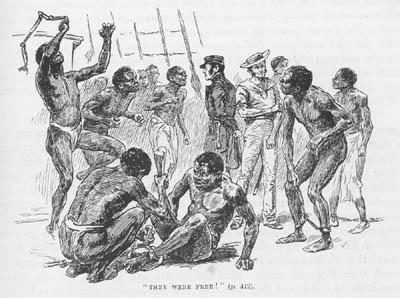
CHEGADA DE ESCRAVOS AO BRASIL
a bordo do navio brasileiro Paquete do Rio, em 1846* !
O texto abaixo fala por si, bem como a sua origem. Isto desmitifica o caráter nacional do racismo ou do esclavagismo. E lembra aos distraídos que o racismo e a escravatura são antes do mais aspectos da exploração humana, duma classe social sobre outra classe social. O racismo mais não é do que a ideologia do esclavagista! Nada tem a ver com pátrias. No limite, nem com a cor da pele:
Um dia, à chegada de um navio, aqui na Rocha do Conde de Óbidos, um filho de um dos passageiros, vindo pela primeira vez à Metrópole, e que assistia da amurada à descarga das malas de porão, disse ao pai: "Pai, aqui em Portugal, os pretos são brancos!"
Isto a propósito das tentativas para diabolizar todos os portugueses como se a sua índole maldosa e desapiedada tivessem inventado a escravatura ou fossem responsáveis pela sua disseminação pelo mundo fora, séculos a fio! Não foi bem assim! :
SourceArthur Thomas Quiller-Couch, ed., The Story of the Sea (London, 1895-96), vol. 2, p. 441 (Courtesy of The Mariners' Museum, Newport News, Virginia)
CommentsCaption: "They were Free." Included in a lengthy chapter on the slave trade, this scene illustrates a detailed description of Africans liberated from a Brazilian slaving vessel, the "Paqueta de Rio," by a British naval vessel, the "Cygnet," off Sherbo, in West Africa. The account initially appeared in the "Sierra Leone Watchman" (November 15, 1846) which reported that there were 547 Africans on board the slaver: "The slaves were all stowed together, perfectly naked . . . The slaves who were confined in the hold--it being utterly impossible for the whole of them to remain on deck at one time--were in profuse perspiration . . . The smell on board was dreadful . . . . the greater part of the slaves were chained together with pieces of chain, which were passed through iron collars round their necks; iron shackles were also secured round their legs and arms . . . .[After they were freed, the slaves] set to work, and, with the billets of wood which had hitherto formed their bed, knocked off each other's shackles . . . . They were branded like sheep. Letters were burnt in the skin two inches in length. Many of them, from the recent period it had been done, were in a state of ulceration . . ." (p. 442). Although this illustration is sometimes reproduced in secondary sources on slavery which erroneously give the impression it is based on an eye-witness drawing, the illustration is the late nineteenth century artist's imaginative rendering and is a complete fabrication.
In :http://hitchcock.itc.virginia.edu/Slavery/details.php?filename=mariners07
*- Notar que à data, o Brasil já era independente de Portugal ia para 25 anos!
Sem comentários:
Enviar um comentário